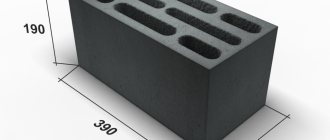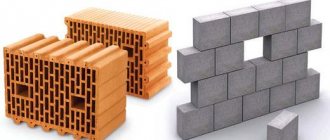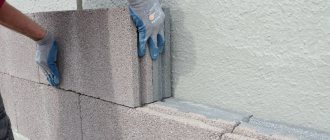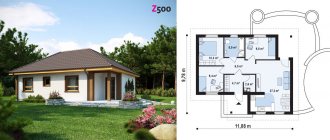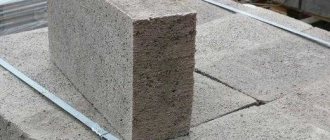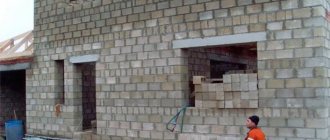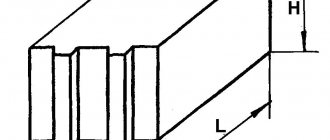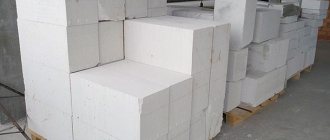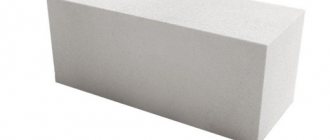Expanded clay concrete block, as a building material, is something between brick and foam block. The similarity with brick can be seen in the similar values of strength and frost resistance. The material is compared with gas and foam blocks due to similar dimensions, the same weight and the same low thermal conductivity. However, despite the positive properties, expanded clay concrete blocks are not the most popular building material in our country, unlike brick and aerated concrete. In European countries, the construction of buildings from this material is much more developed.
As the name suggests, the main components that make up the block during production are cement mortar and expanded clay.
The composition of the cement mortar is standard - it includes cement, sand and water.
Expanded clay is balls of clay with a fraction of 5 to 12 mm, which have gained the necessary strength by firing in special ovens. Each ball has a crust of baked clay, which is formed due to the high temperature in the oven.
The ratio of components in production is 1*2*3 (1-cement, 2-sand, 3-expanded clay).
Depending on the type of structure, the frame of which will consist of expanded clay concrete blocks, specific additives can be added to the composition, which will slightly change the properties of the material. For example, they will increase the thermal conductivity value or reduce moisture absorption.
Scope of application
Types of buildings in which expanded clay concrete block can be used:
- Low-rise construction (number of floors no more than 3).
- Construction of a foundation or basement.
- Fence made of stone blocks.
- Construction of a bathhouse.
- Construction of a garage.
- Cellar.
- Monolithic frame housing construction, where the outer walls made of expanded clay concrete are not load-bearing, so there are no restrictions on the number of storeys in this case.
Manufacturing
Of course, the bulk of expanded clay blocks are manufactured in industrial conditions using special equipment, taking into account all the provisions described in GOST 6133-99 “Concrete wall stones. Technical conditions". However, you can make this material yourself. To do this you will need some materials and tools:
- Electric concrete mixer with a capacity of 130 liters.
- Container for the prepared solution.
- Expanded clay.
- Sand.
- Cement.
- Water.
- Plasticizer (a special substance included in the expanded clay-cement mortar to improve the properties of plasticity and strength). In household conditions, simple liquid soap is usually used.
Forms for the construction mixture also need to be made independently. Sizes can be either standard or custom. When filling with the finished mixture, one condition must be met - the form must be completely filled in one mixing in order to ultimately obtain the most uniform and durable expanded clay concrete block.
Strengthening (sometimes the term “ripening” is used) occurs over at least a week. During this period, it is necessary to water the material with water, thereby protecting it from drying out.
Which tongue-and-groove slabs to choose: hollow or solid
For the construction of interior partitions, brick, plasterboard and tongue-and-groove slabs are used. All methods are good, but they have their pros and cons. But the construction of walls from tongue-and-groove slabs has a number of advantages: speed of work, simple installation and price of the material. It is not surprising that this material is chosen for installing partitions in homes.
The tongue-and-groove slab is a monolithic rectangular block. There are grooves on two sides of the rectangle, and ridges on the other, which is why it is called tongue-and-groove. This design allows the blocks to be joined together evenly and without gaps. To create interior partitions, builders use tongue-and-groove panels, which are well suited for residential premises. The material from which the slabs are made is not afraid of fire. It consists of gypsum resin, which does not burn. The products are safe for health, they are made from natural material. Partitions are even made in children's rooms.
Tongue-and-groove slabs are produced in two types: ordinary or moisture-resistant.
Non-moisture-resistant products are made from gypsum with the addition of plasticized additives, the panels are usually gray in color. In addition to gypsum, the composition of a moisture-resistant panel includes cement and granulated blast furnace slag. They are produced in green color. It is not recommended to make lintels from ordinary gypsum boards in rooms with high humidity. Green tongue-and-groove panels are used for bathrooms.
Gypsum blocks are made hollow and solid:
- Solid products have a solid monolithic structure. They are durable, the partition cannot be broken even if you hit it with your foot. They are made 667 x 500 x 80 mm, block weight 32 kg.
- Hollow ones are distinguished by the fact that they have uniform longitudinal holes. This feature makes it lighter, thereby reducing the load on the supporting structure. I make the slabs the same size as solid ones, but the weight of the block is 24 kg.
Weight and strength are the two most important differences between tongue-and-groove slabs. To mount heavy objects: cabinets, televisions, it is better to make a solid wall, since it is more difficult to install a mount in a hollow one. In other cases, a lightweight panel is chosen.
Solid blocks are used for the construction of partitions in private houses, since hollow products can harbor harmful insects and rodents.
Price, weight of material, speed of work, ease of installation make tongue-and-groove slabs for the construction of lintels in a house unrivaled. You can install them yourself without hiring builders.
Pros and cons of the material
Expanded clay concrete blocks have a number of positive qualities:
- Environmental friendliness . Only environmentally friendly components are used in production, which pose no danger to human life or the environment.
- High strength. It has already been said that the material can be used as the foundation of a small residential building. The role of the foundation can only be played by building materials that have the necessary strength.
- Low price (below are examples of the cost of 1 m3 of expanded clay concrete masonry in relation to the cost of masonry made from other materials).
- Easy to manufacture and install.
- Not subject to fire and rotting.
- Good soundproofing characteristics.
Like all building materials, in addition to the positive properties, there are also disadvantages:
- Increased porosity of the material.
- Low thermal insulation properties, which lead to the need to use additional insulation with special materials (mineral wool, polystyrene foam).
- Use of low-quality raw materials in production.
Compound
Expanded clay block is a building stone obtained through the process of semi-dry vibration pressing and has a rectangular shape. The constituent components are:
- cement grade 400;
- sand;
- Expanded clay of strength P150-P200.
- water.
To produce the material, recommended proportions of raw materials are used. Changing the ratio affects the final result. This principle allows you to improve strength and increase the density of the product. The filler fraction affects the average density of the material. The table shows the proportions of the working mixture for the production of expanded clay blocks.
| Density of expanded clay concrete | Cement | Expanded clay, bulk density | Sand | Water | ||
| kg | kg/m2 | kg | m3 | kg | l | |
| 1000 | 250 | 700 | 720 | — | — | 140 |
| 1500 | 430 | 700 | — | 0,8 | 420 | |
| 1600 | 430 | 600 | — | 0,68 | 680 | |
| 1600 | 400 | 700 | — | 0,72 | 640 | |
| 1700 | 410 | 600 | — | 0,56 | 880 | |
| 1700 | 380 | 700 | — | 0,62 | 830 | |
| In the table, the consumption of components is given per 1 m3. | ||||||
To improve performance, plasticizers are added to the mixture to increase plasticity and prevent block cracking.
The main operational characteristics of the product include:
- Low labor costs. The light weight of the blocks allows for faster work.
- Small load on the foundation of the object.
- Environmental friendliness. The product is not dangerous to human life.
- Not subject to rotting and fire.
- Long service life of the material.
The disadvantages of expanded clay concrete are porosity and low thermal insulation, so insulation materials are additionally used.
Solid and hollow expanded clay concrete block
There are two types of expanded clay blocks used in construction – solid and hollow.
Solid blocks differ from hollow ones in having a higher strength value and are used in critical structures (foundations, load-bearing fences).
High strength is achieved using vibration compaction, a method used in production. But it is necessary to take into account that the absence of voids slightly increases the weight of an individual unit of material.
Hollow blocks have lower strength, but their heat and sound insulation values are higher. In addition, the presence of voids means less consumption of raw materials, which leads to lower costs.
Material calculation
Before starting the construction of a building or structure made of expanded clay concrete blocks, it is necessary to calculate the volume of material that will need to be used. To do this, using the project, it is necessary to calculate the total length of the walls, which is multiplied by their width and the height of the ceiling, ultimately obtaining the total volume of the masonry.
To calculate the number of blocks, the total volume is divided by the volume of one block, equal to 0.014 m3 . In order not to experience a shortage of material, 20% must be added to the resulting value, since during the construction process a certain amount of material becomes unusable in any case.
Some recommendations when designing a block building:
- When installing the external wall of a low-rise building, the frost resistance value of the block must be at least F50.
- The thickness of the masonry mortar seam is maintained within 1-3mm.
- In addition to cement mortar for masonry, it is possible to use adhesive (as in the case of SIBIT masonry). This option involves increasing the thickness of the seam to 1-1.5 cm.
- The blocks are laid out in one row if the wall thickness does not exceed 30 cm. In other cases, two or more rows are installed.
- In places where the walls are adjacent to each other, rigid connections (metal profiles) are used.
- To increase the strength and integrity of the wall structure, it is permissible to install a reinforcement frame (or simply metal rods) with a diameter of up to 1 cm between the rows of blocks, which is recessed into the masonry mortar. It is not necessary to reinforce each row - it is enough to do it in 2 - 3 rows of the wall.
Types of blocks
Classification of building materials is made according to various parameters:
- size and weight (188x190x390 and 188x90x390 millimeters);
- by purpose (wall, ventilation, foundation);
- surface texture (smooth, polished, corrugated, chipped);
- presence of voids.
Manufacturers use product labeling:
- C – for the construction of walls;
- K – stone;
- P – for installation of partitions inside the facility;
- L - facial;
- R – ordinary (with external finishing);
- PS – hollow.
Many technical characteristics and types of material depend on the structure:
Solid expanded clay concrete blocks are heavy and durable, therefore they are used for the construction of external walls of the building. It is used in the construction of multi-storey residential and industrial facilities, for installation of frames in monolithic buildings and foundations. The main features are:
- high heat capacity;
- excellent frost resistance;
- high strength index;
- air exchange.
Expanded clay concrete is a porous, breathable material that can regulate humidity levels.
Hollow expanded clay concrete blocks are lightweight and less durable. The form has a different number of voids, so the product is light. It is worth noting additional material indicators:
- Due to the low weight of the product, the load on the foundation is reduced. The strength of the structure is not reduced.
- Allows you to reduce the financial costs of construction. By reducing the consumption of cement and fillers.
- Sound insulation, thermal conductivity, and vapor permeability are improved.
Slotted expanded clay concrete blocks are produced with two, three, four, six, eight hollow cores. The material is used for the construction of external and internal walls. Experts recommend using the product for the external walls of low-rise buildings in order to place heat-insulating material in the voids. This is necessary if external thermal insulation is not provided.
Estimated cost
As one of the positive aspects of blocks made of expanded clay concrete, it was said that this material has a low cost.
For comparison, you can give an example of the cost of 1m3 of masonry made of expanded clay concrete blocks and other building materials:
- Expanded clay concrete masonry = 2250 rub.
- Foam concrete masonry = 2650 rub.
- Brickwork - from 5000 rub.
Prices are approximate, because many factors must be taken into account in order to obtain accurate figures. But, nevertheless, they show the general price relation to other materials.
What is written about such blocks in GOST
Types and technical requirements for production are reflected in GOST 33126-2014 “Expanded clay concrete wall blocks”. It was adopted in 2014, it reflects the main provisions for production:
- division of expanded clay blocks by type and purpose,
- on the composition and quality of materials used in their production;
- the possibility of deviations in color and texture, as well as from standard dimensions in width, length, height of the product is established;
- individual brands are distinguished by strength and frost resistance;
- requirements for labeling, packaging, and transportation of finished products are recorded; the permissible percentage with cracks and other defects for one batch is indicated;
- rules for acceptance of products by the manufacturer, quality control methods, manufacturer's warranties.
GOST 33126-2014 is aimed at improving the quality and standardization of expanded clay concrete blocks, as well as protecting the interests of manufacturers, builders, consumers of both the material itself and buildings made from them.
